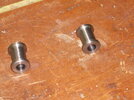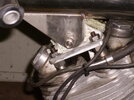thanks for the offer Howard, and you're right, Hastelloy makes a rod for welding mild steel to SS. I ordered a 2" bung and cap in 316 SS today, it should be here shortly.
If I hadn't already ordered this 2" set, the 1.5 inch set with Al. cap and O ring seal in the link Bruce provided would be a good choice.
The set I am getting relies on pipe thread to seal, so some pipe gunk will be needed, especially with stainless as it doesn't mush together like steel or brass.
If I hadn't already ordered this 2" set, the 1.5 inch set with Al. cap and O ring seal in the link Bruce provided would be a good choice.
The set I am getting relies on pipe thread to seal, so some pipe gunk will be needed, especially with stainless as it doesn't mush together like steel or brass.


